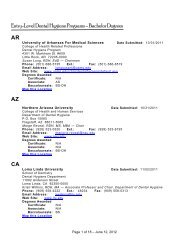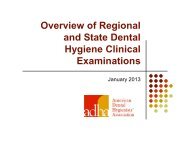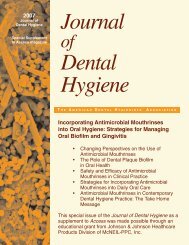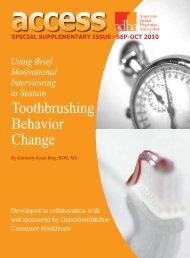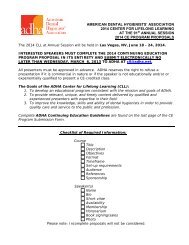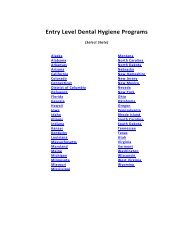Relationship Between Oral Health and Systemic Disease - American ...
Relationship Between Oral Health and Systemic Disease - American ...
Relationship Between Oral Health and Systemic Disease - American ...
Create successful ePaper yourself
Turn your PDF publications into a flip-book with our unique Google optimized e-Paper software.
Table I: Physiologic Rationale for Cardinal Signs of InflammationCardinal Signs of InflammationPhysiologic RationaleRubor (redness)Increased vascularityTumor (swelling)Exudation of fluidCalor (heat)Dolor (pain)Functio laesa (loss of function)A combination of increased blood flow <strong>and</strong> therelease of inflammatory mediatorsThe stretching of pain receptors <strong>and</strong> nerves bythe inflammatory exudates, <strong>and</strong> by the releaseof chemical mediatorsA combination of the above effectsMcMahon RFT, Sloan P. Essentials of pathology for dentistry. Edinburgh: Churchill Livingstone; 2000, p. 26.The inflammatory response consists of a vascular <strong>and</strong> a cellularreaction. These reactions are mediated by chemical factorsderived from plasma proteins or cells. The classic signs ofinflammation are redness, swelling, heat, pain <strong>and</strong> loss of function.The physiologic explanations for these signs appear inTable I. Other signs of inflammation include fever, leukocytosisor an increase in the number of circulating white blood cells,the presence of acute-phase proteins including C-reactive proteins(CRP), fibrinogen <strong>and</strong> serum amyloid A protein (SAA),<strong>and</strong> sepsis.There are two types of inflammation: acute <strong>and</strong> chronic.Acute inflammation is characterized by a rapid onset <strong>and</strong> shortduration. It manifests with exudation of fluid <strong>and</strong> plasma proteins,<strong>and</strong> emigration of leukocytes, most notably neutrophils.Chronic inflammation is of prolonged duration <strong>and</strong> manifestshistologically by the presence of lymphocytes <strong>and</strong> macrophages<strong>and</strong> results in fibrosis <strong>and</strong> tissue necrosis. When inflammationcontinues for prolonged periods of time, it can be thought of asthe healing process in overdrive, <strong>and</strong> deleterious changes canoccur to localized tissues as well as the entire body.In appreciating the inflammatory process, it is important tounderst<strong>and</strong> the role of chemical mediators. These are the substancesthat tend to direct the inflammatory response. Theseinflammatory mediators come from plasma proteins or cellsincluding mast cells, platelets, neutrophils <strong>and</strong> monocytes/macrophages.They are triggered by bacterial products or host proteins.Chemical mediators bind to specific receptors on target cells <strong>and</strong>can increase vascular permeability <strong>and</strong> neutrophil chemotaxis,stimulate smooth muscle contraction, have direct enzymatic activity,induce pain or mediate oxidative damage. Most mediators areshort-lived but cause harmful effects. 1 Examples of chemicalmediators include vasoactive amines (histamine, serotonin),arachadonic acids (prostagl<strong>and</strong>ins, leukotrienes) <strong>and</strong> cytokines(tumor necrosis factor <strong>and</strong> interleukin–1).Inflammation <strong>and</strong> <strong>Oral</strong> <strong>Health</strong>The inflammatory process significantly affects the periodontium.Plaque biofilm releases a variety of biologicallyactive products as gram-positive <strong>and</strong> gram-negative bacteriacolonize the tooth surface around the gingival margin <strong>and</strong>interproximal areas. These products include endotoxins,cytokines <strong>and</strong> protein toxins. 2 These molecules penetrate thegingival epithelium <strong>and</strong> initiate a host response that eventuallyresults in gingivitis. Evidence of this can be seen clinically withchanges in tissue color from pink to red, swelling, <strong>and</strong> bleedingupon probing. 3 Because gingivitis is typically not painful, itmay remain untreated for years. Worse, it may be viewed bypractitioners as something that requires less concern than periodontitis.Nevertheless, chronic gingivitis that persists for yearsmay provide the basis for greater concern for systemic healththan a periodontitis condition that is more readily treated.As the biofilm continues to proliferate, soluble compoundspenetrate the sulcular epithelium. This, in turn, signals the gingivalepithelium to produce chemical mediators includinginterleukin–1 beta (IL-1‚), prostagl<strong>and</strong>ins, tumor necrosis factoralpha (TNF-α), <strong>and</strong> matrix metalloproteinases. 4 Theseproducts recruit neutrophils to the area <strong>and</strong> influence chemotaxis,<strong>and</strong> can cause increased permeability of gingival vesselsthat permits plasma proteins to emigrate from the blood vesselsinto the tissue. As the inflammatory process progresses, additionalmediators are produced, <strong>and</strong> more cell types are recruitedto the area including neutrophils, T-cells, <strong>and</strong> monocytes.Continued inflammation results in signaling of fibroblasts <strong>and</strong>production of proinflammatory cytokines in the tissues.Antibodies specific to oral bacteria circulate in the peripheralblood. The acute-phase response becomes activated <strong>and</strong> CRP,fibrinogen <strong>and</strong> complement are produced both by local cells<strong>and</strong> within the liver. 5,6 These proteins may further exacerbate2 access—special supplemental issue—april 2006





